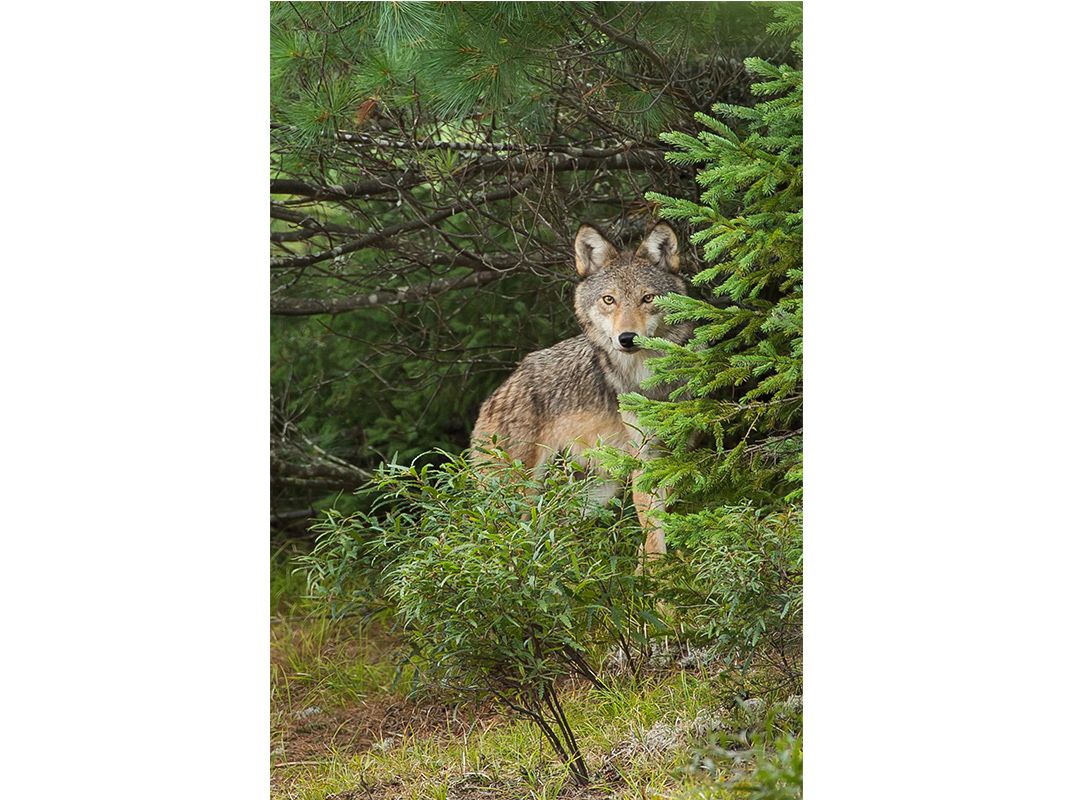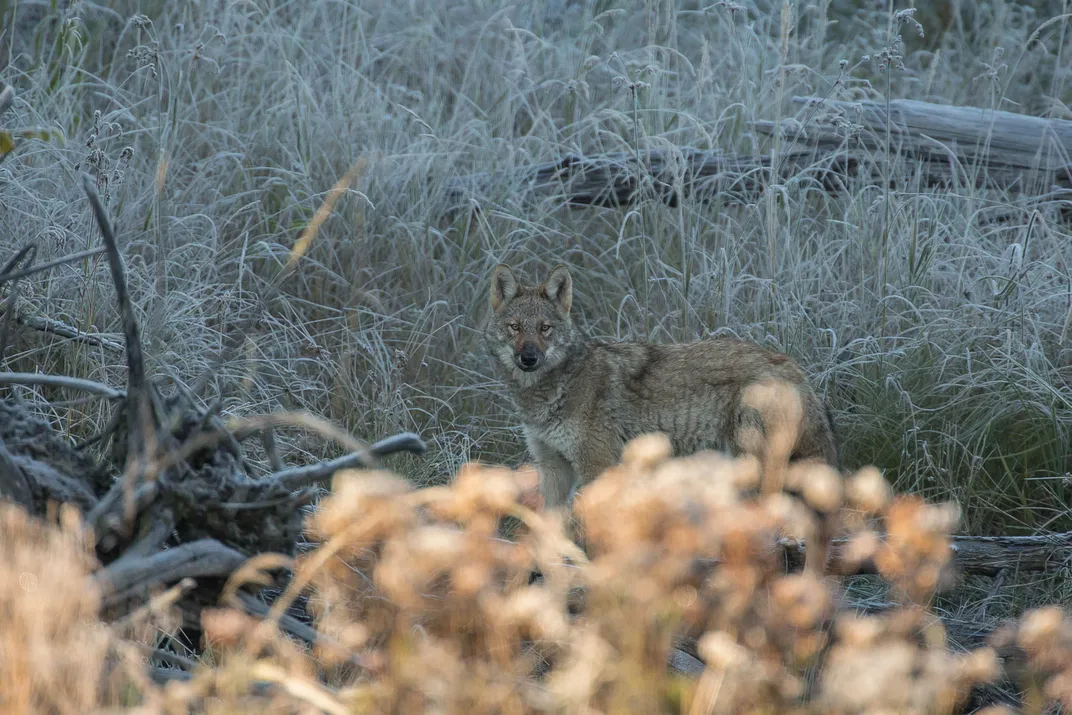Rare Wolf or Common Coyote? It Shouldn’t Matter, But It Does
The concept of species is flawed, but it still has a huge bearing on conservation policy
/https://tf-cmsv2-smithsonianmag-media.s3.amazonaws.com/filer/97/88/9788850e-1bbd-41d0-b2eb-f1ffd5085f18/algonquinwolfstare.jpg)
Drive down the main highway that runs through Canada’s Algonquin Provincial Park after dark, and you may hear one of the eeriest sounds in nature. That shrill, haunting lament is the howl of the Algonquin wolf, which has roamed this land for centuries.
Also known as eastern wolves, Algonquin wolves are considered almost mythical by many Canadians. According to an Iroquois legend, these elusive creatures rescued mankind from an apocalyptic flood. Today they are rarely seen, preferring to stay hidden as they stalk moose and deer in their vast wooded territory. They are distinctive in appearance, with rusty brown fur and short, lean bodies. In many ways, they look identical to coyotes.
That "resemblance" has often proved deadly.
The Canadian government has spent more than 10 years deliberating over whether Algonquin wolves are a unique species. In a key decision on June 14, they decided they were and listed them as “threatened,” which makes it illegal to hunt them. But last month, new genetic research in the journal Science Advances asserted just the opposite.* That study suggests that between 50 and 70 percent of the eastern wolf’s genome derives from gray wolves, while the rest comes from coyotes. If the new study is correct, then the “Algonquin wolf” does not exist; it is simply a hybrid.
Of course, one genetic study does not put the debate to rest. Some scientists believe the evidence is questionable, saying that the study conflated Great Lakes wolf populations with Algonquin wolves. They also point out that researchers relied on just two genetic samples from wolves within Algonquin Provincial Park. “They are not pure and we’ve never said they were pure,” says Linda Rutledge, a geneticist focusing on the eastern wolf at Princeton University who was not directly involved in the study. “But absolutely there is something unique about the Algonquin wolf.”
The problem is, no one has been able to clearly define what that “something” is. And without a definition, prioritizing the survival of one group of endangered animals—no matter how beloved or culturally important—can prove challenging.

Algonquin wolves are not the only animals facing a high-stakes identity crisis. Other quasi-hybrids like Florida’s pumas, North Carolina’s red wolves and lynx in Minnesota feel the same human pressure to prove their distinctiveness. Such hybrids are increasingly common as human encroachment and climate change transform habitat ranges around the world and cause greater levels of interbreeding. Moreover, advancements in technology are revealing genetic complexity in new depth, which makes it trickier than ever to separate one species from the pack—and thus decide which groups should be preserved.
Taxonomists have traditionally defined a species as a group of genetically similar individuals that can interbreed. But scientists have known since the 19th century that nature is too complex to be neatly packaged into distinct species. To the dismay of taxonomists, evolution is a fluid, untidy process that naturally involves genetic mixing and inter-species breeding. Many animals have mixed genomes, including humans, whose DNA contains traces of Neanderthal.
Unfortunately, laws designed to protect wildlife in North America have not caught up with these nuances in evolutionary theory. “We are having to deal with a fundamental problem,” says Rutledge, who has carried out genetic tests on over 100 eastern wolves. “The Endangered Species Act forces us to categorize animals taxonomically, when new science is revealing lots of complication. 'Species' is a human construct. We apply it and it is not always a neat fit.”
Contemporary wildlife discussion often lags behind new science. “We would like to think of the earth as a more simple place with more simple species boundaries,” says George Amato, director of the Sackler Institute for Comparative Genomics. “But evolution is messy. The real dilemma for me is: How do we use complex taxonomy to make reasonable conservation decisions?”
The Algonquin wolf embodies many of these emerging challenges. While data on wild populations is thin, park officials estimate there are between 230 and 1,200 individuals remaining. Conservationists who do consider the Algonquin wolf as its own species fear that these low numbers, which indicate an already narrow gene pool, are being mistakenly whittled down by people targeting coyotes. Ontario has close to 410,000 registered hunters and trappers—the highest number of any province in Canada.
As a result, some conservationists want to expand the umbrella of protection for the Algonquin wolf to embrace coyotes as well. “You need to protect coyotes to successfully protect eastern wolves,” says Hannah Barron, director of wildlife conservation at Earthroots, an Ontario-based nonprofit. “You can’t tell the difference between a coyote and an eastern wolf without a genetic test. Not all hunters report what they kill. We have no idea how many are dying.”

Hunters aiming for coyotes are also concerned. Killing a threatened species in Canada comes with a possible prison sentence and a hefty $25,000 fine—not a punishment most are willing to pay for their kill. Yet the visual similarity between coyotes and Algonquin wolves means many could easily be accidentally shot or trapped. “Harvesting an eastern wolf by mistake is a major concern for us,” said Mark Ryckman, a wildlife biologist with the Ontario Federation of Anglers and Hunters. “We are seeking guidance from officials on what we should do to prevent it.”
The Canadian government has proposed forming three protection zones for Algonquin wolves in Ontario, in which coyote hunting would also be banned. Critics say these zones will provide only isolated islands of protection, and that travelling between them could be lethal for wolves. Research by Brent Patterson, a biologist and wolf researcher with Ontario's Ministry of Natural Resources and Forestry,* suggests as many as 80 percent of Algonquin wolves die within a year of leaving existing protected areas.
While the debate rages over the distinctness of the eastern wolf, others question why genetic uniqueness is considered so important in the first place. Many biologists say the concept of a species is flawed, and that conservation programs need to look at the bigger picture. “Rather then trying to place wolves in arbitrary taxonomy boxes, we need to look more at the ecological need for certain species,” says Maggie Howell, executive director of the Wolf Conservation Center in New York state. “All wolves are a keystone species. They benefit the landscape around them.”
In Yellowstone National Park, where wolves were reintroduced in 1995, research has revealed wolves have a net positive impact on their environment by keeping deer populations low, which allows for reforestation. But wolf hybrids are equally capable of fulfilling this ecological role. In other words, whether or not the Algonquin wolf is “pure” or hybrid doesn’t matter from an ecological perspective. A growing body of scientists argue that hybridization can actually benefit some animals, improving their genetic diversity and adaptability.
Moreover, the attitude that species should avoid genetic mixing has disquieting roots in eugenics. “Our notion of genetically ‘pure’ animals goes all the way back to the formation of racial types among people,” says Robert Wayne, a canine expert and geneticist at the University of California at Los Angeles and co-author of the recent study finding that North American wolves were hybrids. “We need to get over that. We’re too focused on bracketing nature into fixed species when we know the processes of evolution are more dynamic.”
In our quest to establish distinct species, Wayne points out, we are overlooking the fact that historically all wolves have engaged in some interbreeding in North America. Although his own research challenges the genetic heritage of the eastern wolf, he says a mixed ancestry doesn't mean the animals should lose their protection. “At the end of the day, this is a human problem of perception,” says Wayne. “Our inability to define eastern wolves is cultural. It’s us.”
Editor's Note, August 4, 2016: This article originally misstated that a study on North American wolves was in Evolutionary Genetics; it actually appeared in Science Advances. Also, Brent Patterson is with Ontario's ministry of natural resources, not Canada's.